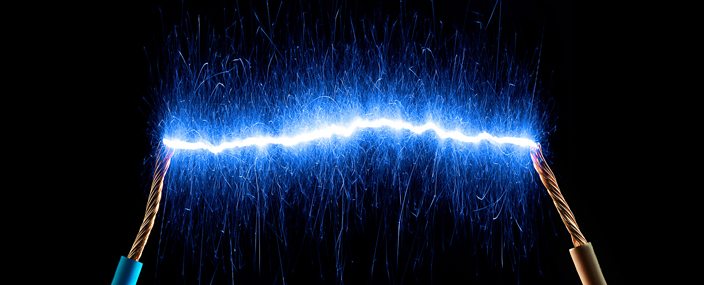Electricity (from the Greek ήλεκτρον — amber; previously also thunder) is a branch of physics that studies electrical phenomena: the interaction between charged bodies, polarization phenomena, and the passage of electric current.
Electricity is a natural phenomenon associated with the existence, movement and interaction of electric charges.
Electrical phenomena are the basis of modern means of energy production, transportation and distribution, and therefore are the basis of numerous applications in modern technology.
Related disciplines
The connection between electrical and magnetic phenomena is studied by electromagnetism. Electrodynamics, which covers electricity and magnetism, also studies electromagnetic waves. In contrast to electrodynamics, the branch of electricity that studies only stationary electric charges is called electrostatics.
Applied sciences such as electrical engineering, electrochemistry, etc., are based on electricity.

History
Electrical phenomena were known even in ancient times, to the ancient Greeks, Phoenicians, and the inhabitants of the Mezhiryche region. The fact that when rubbing amber acquires the property of attracting light objects to itself, was described in the 600s BC. e. Thales of Miletus. Thales, however, did not distinguish electricity from magnetism, considering it to be one phenomenon, but only amber acquires such a strange property when rubbed, and in magnetite it is permanent.
A new step in the study of electrical phenomena was made in 1600 by the English doctor William Gilbert. After conducting research on electrical and magnetic phenomena, he published a book in which he concluded that the properties of a permanent magnet and the ability of rubbed amber to attract objects are definitely different phenomena. Gilbert began to use the Latin word electricus — amber-like — to describe such a property. In his book, Gilbert also concluded that the Earth is a magnet, which is why the compass needle points to the pole.
In the middle of the 17th century, Otto von Goericke invented the electrostatic generator.
Stephen Gray’s experiments showed that electricity could be transmitted over long distances (up to 800 feet) using conductors (moistened filaments) if contact with the ground was avoided and insulation was used. This is how the research of currents began and the foundations of the division of materials into conductors and dielectrics were laid.

Charles Dufet discovered two different types of electricity, calling them “vitreous” and “resinous” (now called positive and negative charges), showing that like charges repel and opposite charges attract. Du Fe also divided substances into conductors and insulators, calling them “electric” and “non-electric”.
Experiments conducted by Benjamin Franklin in 1752 demonstrated that lightning has an electrical nature.
In 1791, Luigi Galvani announced the discovery of bioelectricity. In 1800, Alessandro Volta built the first battery – a volt column. The new type of current source was much more reliable than the electrostatic generators used before. In 1820, Andre-Marie Ampere discovered the connection between electricity and magnetism. In 1821, Michael Faraday invented the electric motor, and in 1827, Georg Ohm established a mathematical law describing the current in an electric circuit.
It is difficult to list all scientific discoveries in the field of electrical phenomena in the first half of the 19th century. The discovery of electromagnetic induction by Faraday in 1831 opened the way to the production and use of electrical energy on a large scale, and the end of the 19th century became an era of numerous inventions in the field of electrical engineering. By the end of the century, through the efforts of such outstanding scientists and inventors as Nikola Tesla, Thomas Alva Edison, Werner von Siemens, Lord Kelvin, Galileo Ferraris, and many others, electricity had turned from a scientific curiosity into a driving force of the second industrial revolution.
